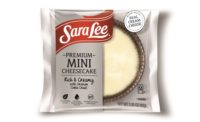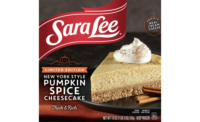Sara Lee Corp. hopes to reduce the time and cost to develop new products into market with its new North American innovation campus, The Kitchens of Sara Lee.
Sara Lee Corp. hopes to reduce the time and cost to develop new products into market with its new North American innovation campus, The Kitchens of Sara Lee.
The 120,000-sq.-ft. research and development center, located across the street from its headquarters in Downers Grove, Ill., houses more than 100 research and development professionals, including chefs, scientists, engineers and packaging designers.
The Kitchens of Sara Lee was dedicated in honor of the company founded by Charles Lubin in 1949. Sara Lee Schupf, the actual “Sara Lee” and the daughter of Lubin, was on hand for the dedication.
The state-of-the-art facility allows research and development teams to test product, processes and preparations before implementing mass production, according to the company.
By putting all of its North American food and beverage researchers under one roof, the company also wants to encourage multidisciplinary cooperation among its marketing department, consumer insight division and the various R&D staffers in the bakery, packaging, foodservice, meat and beverage units to spark greater new product innovation.
“Our dedication to innovation, and in turn increasing consumer and customer value, has been an integral part of Sara Lee’s transformation,” says Brenda Barnes, chairman and CEO of Sara Lee Corp. “Now, with The Kitchens of Sara Lee, we are fully equipped to turn consumer insights into products that differentiate us in the marketplace.”
Hixson Architecture & Engineering in Cincinnati designed the multimillion-dollar center. It includes a bakery bench top room, which consists of areas where bakers and technologists can work together to develop products for Sara Lee’s fresh baked goods line in the bread aisle, as well as for its private label frozen dough products and frozen gourmet desserts and pound cakes.
During a tour of the facility, visitors saw bakers in the fresh packaged goods area mixing multiple, 4- to 5-lb. batches of sponge and dough that was then rounded, sheeted and sent to a proofer before baking in carousel-type ovens. Nearby, another baker hand-decorated a chocolate truffle cheesecake.
On the opposite side of the room, bakers were producing cinnamon rolls on a Rondo-Doge laminate dough line, which also can produce Danish, croissants, pizza dough and other products.
The facility also houses a pilot plant, complete with a 42-in. wide and 32-ft. long tunnel oven by C.H. Babb. The three-zone oven, designed specifically for the lab, features controlled heating rates with variable-speed impingement fans, according to the company. A Scorpion Data logging system allows bakers to record bake conditions and to help improve scale up to the company’s facilities across the nation.
Additionally, the pilot plant houses a Hobart mixer for batters and a Shaffer horizontal, roller bar mixer that can create 300-lb. batches of sponge and dough. The company uses a Reiser Vemag depositor, which can handle everything from muffin batters to bread doughs, according to company officials. The lab also has a cone rounder, makeup system and proofer from Gemini Bakery Equipment.
In other areas, the facility houses packaging labs with rapid prototyping capabilities that can shape plastic and paper prototypes in minutes and test packaging before suppliers begin production. Researchers there say the labs can reduce the development of packages by up to two months compared with outsourcing new packaging as in the past. Company technologists note they also are addressing sustainability issues to shrink packaging to maximize the amount of products it can put on a pallet, thus reducing shipping costs. Moreover, the company is reducing the amount of plastic it uses by hundreds of thousands of pounds annually.
In other areas of the complex, there are beverage labs and raw, cooked and ready-to eat meat labs, which offer bench-top product formulation capabilities, and also simulate Sara Lee plant processes to test product components and packaging prototypes before they enter full-scale production. The labs feature a meat cooker from Heat and Control. The facility is inspected by the U.S. Department of Agriculture and even has an office for a USDA inspector to use.
In the foodservice kitchens, plug-and-play equipment can be custom-arranged to replicate a quick-service restaurant or a foodservice operation. Here, Sara Lee can work with its restaurant customers to develop signature products.
To increase value to its customers, the facility’s sensory and product performance labs assist with turning consumer insights into desired product attributes.
Because of the new facility’s flexibility and customizable resources, Sara Lee North American businesses are better positioned to further improve the innovation process. The Kitchens of Sara Lee brings the research and development teams closer to the brands on which they work, which increases speed-to-market for new products.
“Our vision is to be the most insightful, most innovative and most disciplined food company in the categories we operate in. The Kitchens of Sara Lee represents an exciting new stage for our innovation vision,” says Philippe Schaillee, vice president, marketing, strategy and research and development. “By connecting our consumer, customer and operator insights to the product development process, the new facility will enable our teams to increase success rates for new products.”
Schaillee notes that 15% of Sara Lee revenues come from product innovation over time. Today’s value-conscious consumers, he adds, want products such as quality desserts at a more competitive price.
However, Barnes stresses that value doesn’t necessarily mean a lower price. In fact, premium products can be perceived as having value if they deliver a number of benefits, such as health, that exceed consumers expectations for what they’re paying.
For more information, go to www.saralee.com.






